
Journal of Mining and Earth Sciences, Vol 65, Issue 6 (2024) 11 - 21 11
Evaluate the influence of steel fiber on the
propagation time of ultrasonic waves in high-strength
concrete
Nhan Thi Pham *, Nghia Viet Nguyen
Hanoi University of Mining and Geology, Hanoi, Vietnam
ARTICLE INFO
ABSTRACT
Article history:
Received 23rd May 2024
Revised 11th Sept. 2024
Accepted 06th Oct. 2024
In modern high-strength concrete, steel fibers are commonly added to the
concrete mix to improve its mechanical properties and structure. The steel
fibers typically have a specific length and are randomly distributed to
increase the tensile and bonding strength of concrete structures.
However, the presence of steel fibers can impact the propagation of
ultrasonic waves in concrete, causing alterations in ultrasonic wave
transmission characteristics and potentially affecting the ability to assess
the quality and safety of construction projects. A successfully produced
high-strength concrete (> 60 MPa) from cement, sand, silica fume, and
superplasticizer. Using this concrete mix, the authors fabricated beam
specimens with dimensions of 150 × 150 × 600 mm for both cases with
and without steel fiber reinforcement. Based on the Time-of-Flight
Diffraction (TOFD) ultrasonic testing method, the authors conducted a
series of experiments on high-strength concrete beam specimens. The
results of ultrasonic wave propagation experiments indicated that the
presence of steel fibers at a 2% content increased the time of wave
propagation. On the other hand, curing conditions, specimen
maintenance time, and transmission path distance affected the ultrasonic
wave propagation time in high-strength concrete. Understanding the
influence of steel fiber content on the propagation time of ultrasonic
waves in high-strength concrete can contribute to improving the
inspection and quality assessment processes of construction projects.
Additionally, it helps enhance the understanding of the properties of high-
strength concrete reinforced with steel fibers.
Copyright © 2024 Hanoi University of Mining and Geology. All rights reserved.
Keywords:
Concrete,
Mechanical properties,
Steel fiber,
Ultrasonic Pulse velocity.
_____________________
*Corresponding author
E - mail: phamthinhan@humg.edu.vn
DOI: 10. 46326/JMES. 2024. 65(6). 02

12 Nhan Thi Pham, Nghia Viet Nguyen/Journal of Mining and Earth Sciences 65 (6), 11 - 21
1. Introduction
Ordinary concrete typically exhibits low
tensile strength, ductility, and tensile deformation
capacity (Colyvas et al., 2020; Farhangi &
Karakouzian, 2020; Sadeghian et al., 2021;
Asgharzadeh et al., 2016). Throughout the usage
of concrete components subjected to various
loading stages, it is common to encounter tensile
damage, which can impact the lifespan of the
structure. In practice, for most load-bearing
structures, enhancing tensile strength and
ductility is achieved through the incorporation of
reinforcing elements such as steel bars, or fibers
including steel, glass, and polymer fibers. Unlike
the reinforcement of steel bars, fibers mixed into
a concrete mixture possess characteristics of
short length, discontinuity, and random
distribution throughout the concrete structure,
resulting in better crack control capability
(Prabhakaran et al., 2020; Aghayari & Moradi,
2016; Kazemi et al., 2020).
However, reinforcing with steel fiber alone
cannot completely replace traditional
reinforcement methods. Until now, there have
been numerous studies on steel fiber
reinforcement to improve the mechanical
properties of concrete. Holschemacher et al
(2010) have demonstrated that adding high-
strength fibers increases the load-bearing
capacity of concrete. Additionally, Rossi (1992)
through experiments on concrete specimens and
structural concrete members, has shown the
effectiveness of steel fibers in reducing crack
propagation. The ultrasonic pulse velocity (UPV)
method is one of the most widely used non-
destructive testing (NDT) methods to determine
certain mechanical properties of concrete
(Güçlüer, 2020; Bui et al., 2013). The majority of
studies utilize wave propagation characteristics
such as pulse velocity, travel time, wave
amplitude, and pulse frequency in both indirect
and direct modes to assess the mechanical
properties of the surveyed materials (Nguyen,
2016; Pham & Khong, 2023).
Although the application of ultrasonic pulses
for assessing the mechanical properties of
construction materials has been employed for a
long time, the results related to ultrasonic pulse
propagation evaluation in high-strength concrete
materials, especially high-strength concrete
reinforced with steel fibers, are still limited. The
main objective of this study is to evaluate the
influence of steel fibers on the propagation time of
ultrasonic pulses in high-strength concrete. In this
experiment, high-strength concrete beam
samples were made for both cases containing
steel fibers and not containing steel fibers. Then
use the Ultrasonic Pulse Analyzer to measure the
ultrasonic pulse propagation time in these
concrete beam samples. The pulse propagation
time was recorded under the following
conditions: before the sample was cured in moist
heat after the sample was cured in moist heat for
3 days, and cured under normal conditions for 14
days, 28 days, and 120 days.
2. Experimental Program
2.1. Sample Fabrication Procedure
The mix design for manufacturing the
concrete samples was partially based on the
proportions of the main components from
previously published research. It was adjusted
during the experimental process to meet the
requirement of a compressive strength of over 60
MPa for the concrete samples. The aggregates
used in the production of high-strength concrete
exceeding 60 MPa consist entirely of fine
aggregates without coarse aggregates, with a
water-to-cement ratio of 0.16 and, steel fiber
content of 2%. Additionally, the experiments
utilize active mineral additives such as silica fume
and superplasticizer. The experimental program
is shown in Figure 1.
To ensure accurate results and prevent
command errors during the molding process, the
procedure for casting a 50x50x50 mm cube mold
is synchronized as follows:
Dry mix cement with silica fume for a
uniform mixture (for 2 minutes).
Pour the mixed cement and silica fume into
the mixer and turn on the mixer for even
mixing (for 3 minutes).
Pour water clockwise and counterclockwise
around the mouth of the mixing bowl to
ensure thorough mixing (for 3 minutes).
Pour the superplasticizer around the mouth
of the mixer bowl evenly and let the mixture
rotate (for 5 minutes).

Nhan Thi Pham, Nghia Viet Nguyen/Journal of Mining and Earth Sciences 65 (6), 11 - 21 13
Mix the steel fibers into the concrete
mixture thoroughly (for 3 minutes).
Proceed to pour the concrete into the
prepared mold.
The concrete samples were removed from
the mold after 2 days of maintenance under room
conditions. After demolding, the concrete samples
were maintained under experimental conditions:
air, temperature, humidity, and water according
to the experimental program.
2.2. Composition of high-strength concrete mix
2.2.1. Calculation of the mix composition of high-
strength concrete using the absolute volume
method
In Vietnam, some studies have proposed high
material composition ratios for high-strength
concrete (Van and Bui, 2019; Pham et al., 2020; Le,
2017) for both cases with and without steel rope.
In these studies, the produced concrete met the
requirements, with compressive strength at 28
days ranging from 120÷193 MPa.
According to the absolute volume method,
the volume of 1 m3 of compacted concrete is
considered as the total volume of water,
aggregates, cement, mineral admixtures,
superplasticizers, and the volume of entrapped
air during the mixing process of the concrete mix.
Therefore:
𝐶
𝐶 + 𝑆𝐹90
𝑆𝐹90 +𝑊
𝑊 +𝑆
𝑆 +𝑆𝑅
𝑆𝑅 +𝑆𝑇 + 𝐴
=1000
(1)
Where: C, SF90, S, W, SR - The masses of
cement, silica fume, sand, water, and
superplasticizer;
𝐶;
𝑆𝐹90;
𝑆;
𝑊;
𝑆𝑅500 - The
densities of cement, silica fume, sand, water, and
superplasticizer; ST - The volume of steel fibers in
the concrete mix during mixing; A - the void
volume due to air entrainment in the concrete mix
during mixing.
The density of the materials used in this study
has been determined and presented in Table 1.
Material
C
SF90
S
W
SR
The density of
materials g/cm3
3.15
2.15
2.65
1.0
1.12
According to TCVN 10306:2014 standard,
high-strength concrete is defined as concrete with
a characteristic compressive strength of 55 MPa
or greater at the age of 28 days tested on standard
specimens. Based on this criterion, this study has
investigated and calculated the mix design
components of concrete with an average
compressive strength at the age of 28 days
exceeding 60 MPa, ensuring workability with a
slump range of 150÷250 mm on the slump table.
2.2.2. Selection of material ratios
The material ratios chosen in this study are
based on the findings of numerous research
studies on high-strength concrete (without coarse
aggregates) conducted in many countries around
the world (Asgharzadeh et al., 2016; Prabhakaran
et al., 2020) as well as in Vietnam ( Van and Bui,
2019; Pham et al., 2020; Le, 2017).
The binder consists of 80% Pooc Lang PC40
But Son cement and 20% silica fume ( B = C +
SF90).
Based on the findings of multiple conducted
studies the water/binder (W/B) ratio selected for
this study is 0. 16 (Le, 2023).
Figure 1. Experimental Program.
Table 1. The density of materials.

14 Nhan Thi Pham, Nghia Viet Nguyen/Journal of Mining and Earth Sciences 65 (6), 11 - 21
In terms of aggregate content: based on the
research findings of previous studies in this study,
the sand/binder ratio (𝑆
𝐵) of 1.0 has been chosenv
(Le, 2023; Aghayari & Moradi, 2016).
The amount of superplasticizer additive is
taken at 7.84% of the total adhesive content (Le,
2023). In this study, a superplasticizer is used in a
small amount to reduce water, aiming to adjust
the flowability of the concrete mix on the slump
table.
Steel fibers: The volume ratio of steel fibers is
the percentage of the volume occupied by steel
fibers in the concrete mix, typically ranging from
0.5÷2% of the absolute volume of concrete (Shi et
al., 2020; Vo et al., 2020). The air content
entrained in the concrete mix is 2% of the total
volume of the concrete mix.
2.2.3. Establishing the composition table of high-
strength concrete mixtures
Based on the aforementioned foundations
combined with preliminary experimental survey
results, this study has selected the base material
ratio coefficients as shown in Table 2.
Where:
B = C + SF90
Calculated using the absolute volume method
based on the selected material ratio values (in
Table 2), the mixture composition of high-
strength concrete as shown in Table 3 was
obtained in Table 3.
Proportion
𝑆
𝐵
𝑊
𝐵
𝐶
𝐵
𝑆𝐹90
𝐵
𝑆𝑅
𝐵
ST,
%
A,
%
Non-fiber
reinforced
1
0. 16
0. 8
0. 2
0. 078
-
2
Fiber
reinforced
1
0. 16
0. 8
0. 2
0. 078
2
2
Proportion
C
(kg)
ST
(kg)
SF90
(kg)
W
(kg)
S
(kg)
SR
(kg)
Non-fiber
reinforced
821.8
0.0
205.5
164.4
1.027.3
80.1
Fiber
reinforced
805.0
20.0
201.3
161.0
1.006.3
78.5
The mixture proportions and manufacturing
process of high-strength concrete beams
reinforced with steel fibers are depicted in Figure
2 below.
2.3. The slump flow test
The test to measure the spreading flow of the
concrete mix is conducted immediately after
ceasing mixing and involves the following steps:
Pour the mixed concrete into a flow cone.
Use a tamping rod to compact the mix to be
level with the top of the flow cone.
Lift the cone vertically upwards with two
hands.
Measure the spread flow of the concrete one
minute after lifting the cone and record the result.
The spread flow of the concrete mix achieves a
range of 19.521.5 cm, as shown in Figure 3.
2.4. Compressive strength
Using the ADVANTEST 9 automatic bending
compression system (Controls - Italia) to
determine the compressive strength of the
sample. The loading rate in this case is 1000 N/s.
The experimental samples have dimensions of
50x50x50 mm (following ASTM standards for
testing fine aggregate concrete samples). The
compressive strength of concrete samples
containing steel fibers reaches 101 MPa, satisfying
the requirement of >100 Mpa. For concrete
samples without steel fibers, the compressive
strength reaches 89.99 MPa. The compression
test results and the sample's form upon failure are
depicted in Figures 4 and 5.
From the compression test results, it is
evident that the material mix design specified in
Table 3 fully meets the requirements for
producing high-strength concrete beam samples
with dimensions of 150x150x600 mm for both
cases: with and without steel fiber reinforcement.
These beam samples are appropriately sized for
conducting ultrasonic pulse tests to evaluate the
impact of steel fibers on the ultrasonic pulse
transmission time in high-strength concrete
beams.
Table 2. The material ratios used in the
experiment.
Table 3. The mix design of high-strength concrete.

Nhan Thi Pham, Nghia Viet Nguyen/Journal of Mining and Earth Sciences 65 (6), 11 - 21 15
PC40 Cement
SongLo sand
Superplasticizer
Steel fiber
Silica fume
Mix a dry blend of cement and
silica fume
Pour water into the mixed blend
Add superplasticizer into the
cement + silica fume mixture
Add steel fibers into the mixed
blend
Pour concrete into the mold
Wrap the freshly poured
concrete sample
Remove the mold and curing
Figure 2. The manufacturing process of high-strength concrete beams.
Figure 3. The Experiment measuring the spread flow of concrete.




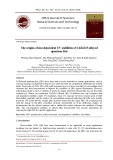
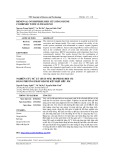
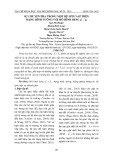
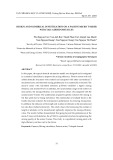
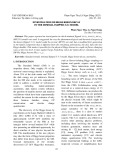
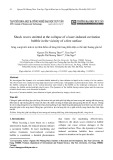
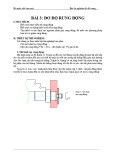








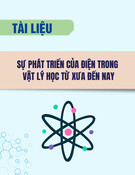
![Bộ câu hỏi lý thuyết Vật lý đại cương 2 [chuẩn nhất/mới nhất]](https://cdn.tailieu.vn/images/document/thumbnail/2025/20251003/kimphuong1001/135x160/74511759476041.jpg)
![Bài giảng Vật lý đại cương Chương 4 Học viện Kỹ thuật mật mã [Chuẩn SEO]](https://cdn.tailieu.vn/images/document/thumbnail/2025/20250925/kimphuong1001/135x160/46461758790667.jpg)




